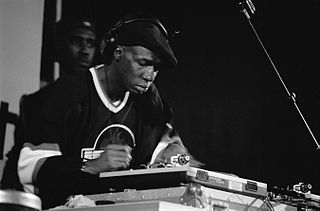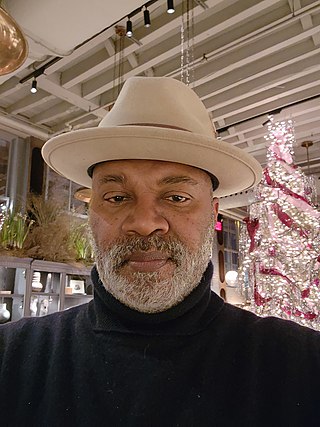
Hip hop dance is a range of street dance styles primarily performed to hip hop music or that have evolved as part of hip hop culture. It is influenced by a wide range of styles that were created in the 1970s and made popular by dance crews in the United States. The television show Soul Train and the 1980s films Breakin', Beat Street, and Wild Style showcased these crews and dance styles in their early stages; therefore, giving hip-hop dance mainstream exposure.

Breakdancing or breaking, also called b-boying or b-girling (women), is a style of street dance originated by African Americans and Puerto Ricans in the Bronx.

Hip hop or hip-hop is a culture and art movement that was created by African Americans, starting in the Bronx, New York City. Pioneered from Black American street culture, that had been around for years prior to its more mainstream discovery, it later reached other groups such as Latino Americans and Caribbean Americans. Hip-hop culture has historically been shaped and dominated by African American men, though female hip hop artists have contributed to the art form and culture as well. Hip hop culture is characterized by the key elements of rapping, DJing and turntablism, and breakdancing; other elements include graffiti, beatboxing, street entrepreneurship, hip hop language, and hip hop fashion. From hip hop culture emerged a new genre of popular music, hip hop music.

Nelson George is an American author, columnist, music and culture critic, journalist, and filmmaker. He has been nominated twice for the National Book Critics Circle Award.
Kenneth James Gabbert, better known by his stage name Ken Swift, is a second generation b-boy, or breakdancer. He was a longtime member and key figure in the Rock Steady Crew, and its former Vice President. He is now President of the Breaklife and VII Gems Hip Hop movement in New York City. Ken Swift began b-boying in 1978, at the age of twelve, when he was inspired by dancers on the Upper West Side of Manhattan. Widely known in the breakdancing world as "the Epitome of a B-Boy," he is widely considered by b-boys to be the individual who has had the greatest influence on breakdancing. Ken Swift is credited with the creation of many dance moves and terminology. His original footwork and "freeze style" became a foundational part of breaking, which were considered new concepts at the time.

Robin Davis Gibran Kelley is an American historian and academic, who is the Gary B. Nash Professor of American History at the University of California, Los Angeles (UCLA).

Clive Campbell, better known by his stage name DJ Kool Herc, is a Jamaican American DJ who is credited with being one of the founders of hip hop music in the Bronx, New York City, in 1973. Nicknamed the Father of Hip-Hop, Campbell began playing hard funk records of the sort typified by James Brown. Campbell began to isolate the instrumental portion of the record which emphasized the drum beat—the "break"—and switch from one break to another. Using the same two-turntable set-up of disco DJs, he used two copies of the same record to elongate the break. This breakbeat DJing, using funky drum solos, formed the basis of hip hop music. Campbell's announcements and exhortations to dancers helped lead to the syncopated, rhythmically spoken accompaniment now known as rapping.

George Carroll, better known as Slaine, is an American rapper and actor. Born in Boston, Massachusetts, where he spent his childhood and teenage years, Carroll moved to New York City in the mid-1990s, where he adopted the moniker of Slaine and started to rap and record hip-hop. In the early 2000s, Carroll became a growing figure in the Boston hip-hop scene, releasing several mixtapes, and the LP Stereotypez (2007) with his group Special Teamz. Later, A Brand You Can Trust (2009) was released, by the rap supergroup La Coka Nostra, where Carroll is joined by Ill Bill, and House of Pain. Carroll’s first solo album A World With No Skies 2.0. (2011) peaked at 33 on the Top R&B/Hip-Hop Albums it, 22 on the Top Rap Albums, 29 on US Independent Albums, and 4 on Top Heatseekers.
Hip-hop or hip hop, formerly known as disco rap, is a genre of popular music that emerged in the late 1960s and early 1970s primarily from African American, Afro-Latin, and Afro-Caribbean musical aesthetics practiced by youth in the South Bronx. Hip-hop music originated as an anti-drug and anti-violence social movement led by the Afrika Bambaataa and the Universal Zulu Nation. The genre is characterized by stylized rhythmic sounds—often built around disco grooves, electronic drum beats, and rapping, a percussive vocal delivery of rhymed poetic speech as consciousness-raising expression. The music developed as part of the broader hip-hop culture, a subculture defined by four key stylistic elements: MCing/rapping, DJing/scratching with turntables, breakdancing, and graffiti art or writing. Knowledge is sometimes described as a fifth element, underscoring its role in shaping the values and promoting empowerment and consciousness-raising through music. In 1999, emcee KRS-One, often referred to as "The Teacher," elaborated on this framework in a Harvard lecture, identifying additional elements that extend beyond the basic four. These include self-expression, street fashion, street language, street knowledge, and street entrepreneurialism, which remain integral to hip-hop's musical expression, entertainment business, and sound production. Girls’ double-dutch was also recognized as a key stylistic component of breakdancing, according to KRS. While often used to refer solely to rapping and rap music, "hip-hop" more properly denotes the practice(s) of the entire subculture. The term hip-hop music is sometimes used synonymously with the term rap music, though rapping may not be the focus of hip-hop music. The genre also centers DJing, turntablism, scratching, beatboxing, and instrumental tracks.
Rock Steady Crew is an American breaking and hip hop group which has become a franchise for multiple groups in other locations. The group's 1983 international hit song "(Hey You) The Rock Steady Crew" peaked at No. 6 on the UK Singles Chart, and reached the top 10 in many European countries. Members of Rock Steady Crew featured in the films Flashdance and Beat Street, which ignited international interest in the b-boy subculture.

Book of Rhymes: The Poetics of Hip Hop is a book by literary scholar Adam Bradley that looks at hip hop music's literary techniques and argues "that we must understand rap as poetry or miss the vanguard of poetry today". The Dallas Morning News described it by saying, "You'll find Yeats and Frost alongside Nas and...Wu-Tang Clan, together forming a discussion on meter and accent, scansion, and slant rhymes". Bradley is an associate professor of English at the University of Colorado at Boulder, with a PhD in English from Harvard University.

Hip-hop theater is a form of theater that presents contemporary stories through the use of one or more of the four elements of hip-hop culture—b-boying, graffiti writing, MCing (rapping), and DJing. Other cultural markers of hip-hop such as spoken word, beatboxing, and hip-hop dance can be included as well although they are not always present. What is most important is the language of the theatrical piece and the plot's relevance to the world. Danny Hoch, the founder of the Hip-Hop Theater Festival, further defines it as such: "Hip-hop theatre must fit into the realm of theatrical performance, and it must be by, about and for the hip-hop generation, participants in hip-hop culture, or both."

How to Rap: The Art & Science of the Hip-Hop MC is a book on hip hop music and rapping by Paul Edwards. It is compiled from interviews with 104 notable rappers who provide insights into how they write and perform their lyrics.

The history of hip-hop dances encompasses the people and events since the late 1960s that have contributed to the development of early hip-hop dance styles, such as uprock, breaking, locking, roboting, boogaloo, and popping. African Americans created uprock and breaking in New York City. African Americans in California created locking, roboting, boogaloo, and popping—collectively referred to as the funk styles. All of these dance styles are different stylistically. They share common ground in their street origins and in their improvisational nature of hip hop.

Tricia Rose is an American sociologist and author who pioneered scholarship on hip hop. Her studies mainly probe the intersectionality of pop music and gender. Now at Brown University, she is a professor of Africana Studies and is the director of the Systemic Racism Project at the Center for Study of Race and Ethnicity in America. Rose also co-hosts a podcast, The Tight Rope, with Cornel West.
Hip hop feminism is a sub-set of black feminism that centers on intersectional subject positions involving race and gender in a way that acknowledges the contradictions in being a black feminist, such as black women's enjoyment in hip hop music and culture, rather than simply focusing on the victimization of black women in hip hop culture due to interlocking systems of oppressions involving race, class, and gender.
Adam Bradley is an American literary critic, professor, and a writer on popular culture. He is the author or editor of six books. Bradley has written extensively on song lyrics as well as on the literature and legacy of the American novelist Ralph Ellison. His commentary has appeared in The New York Times, The Wall Street Journal, The Washington Post and in numerous other publications. He is a professor of English at the University of California, Los Angeles where he directs the Laboratory for Race & Popular Culture.
Hip hop studies is a multidisciplinary field of study that encompasses sociology, anthropology, communication and rhetoric studies, religious studies, cultural studies, critical race theory, missiological studies, art history, dance, musicology, ethnomusicology, music theory, and gender studies. The term "hip hop studies" began circulating in the mid-2000s, and though it is not clear who first coined the term to label the field, the field of hip hop studies is often cited as having been crystallized by the publication of That's the Joint!: The Hip Hop Studies Reader in 2003. That's the Joint! includes approximately 25 years of scholarship, criticism, and journalism. The publication of this anthology was unprecedented, and highlights the evolving and continuous influence of "one of the most creative and contested elements of global popular culture since its advent in the late 1970s." The publication of the first edition of That's the Joint! marked a consolidating moment for the field of hip hop studies because it brought together key writings on hip hop from a diversity of hip hop authorities.
Feminist activism in hip hop is a feminist movement based by hip hop artists. The activism movement involves doing work in graffiti, break dancing, and hip hop music. Hip hop has a history of being a genre that sexually objectifies and disrespects women ranging from the usage of video vixens to explicit rap lyrics. Within the subcultures of graffiti and breakdancing, sexism is more evident through the lack of representation of women participants. In a genre notorious for its sexualization of women, feminist groups and individual artists who identify as feminists have sought to change the perception and commodification of women in hip hop. This is also rooted in cultural implications of misogyny in rap music.

Kyra Danielle Gaunt is an African American ethnomusicologist, Black girlhood studies advocate, social media researcher, feminist performance artist, and professor at the University at Albany in New York State. Gaunt's research focuses on the hidden musicianship of black girls' musical play at the intersections of race, racism, gender, heterosexism, misogynoir, age, and the kinetic-orality of the female body in the age of hip-hop. Her current research focuses on "the unintended consequences of gender, race, and technology from YouTube to Wikipedia."













